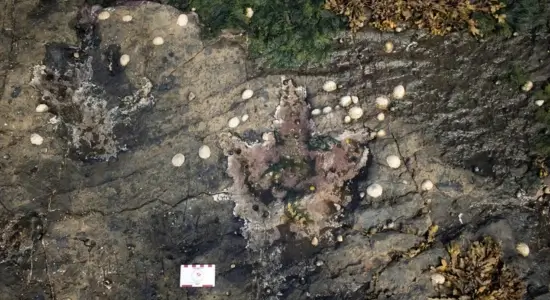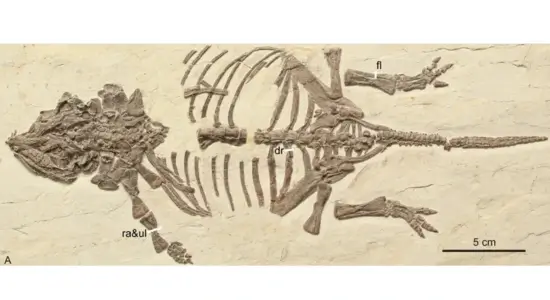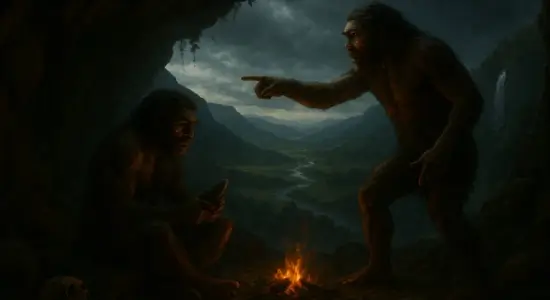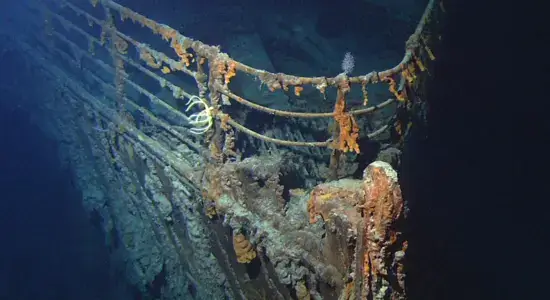Even those giant, scary meat-eaters had to stop for a sip of water! And guess what? Footprints found on the Isle of Skye off the coast of Scotland suggest that both big, predatory dinosaurs and their plant-eating buddies hung out together at the edge of shallow freshwater lagoons 167 million years ago! Can you imagine that?
 Why these footprints matter! Unlocking dinosaur secrets from the Isle of Skye. Image: Paige E. de Polo
Why these footprints matter! Unlocking dinosaur secrets from the Isle of Skye. Image: Paige E. de Polo
Skye’s Dino Treasure Trove and Big Footprints
This discovery happened at the Kilmaluag Formation at Prince Charles’s Point on Skye’s Trotternish Peninsula, where they found a whopping 131 dinosaur footprints! That makes it one of Scotland’s biggest and rarest dinosaur footprint sites, and these footprints are from the Middle Jurassic period, which is a bit of a fossil mystery. Finding tracks from this time is super valuable for scientists trying to figure out how these ancient beasts behaved.
So, what kind of dinosaurs were chillin’ at this prehistoric watering hole? Well, they found some huge, flat, circular footprints that they think belonged to the long-necked, plant-munching sauropods, you know, the Brachiosaurus-type giants. But here’s where it gets really cool: they also found footprints from megalosaurs! These were large, meat-eating dinosaurs, like the T-Rex’s slightly older and less famous cousins. Finding megalosaur tracks is a rare find!
The Mystery of the Fish Resting Burrows
Before this, some of those big, circular depressions were thought to be fish resting burrows, basically, places where fish would hang out. But now, scientists are wondering if some of those “fish burrows” might actually be more dinosaur tracks! Mind blown!
Milling About at the Lagoon and Drone Power
By looking closely at the direction and walking styles (gaits) of these ancient giants, the team thinks that the dinosaurs would have gathered at the edge of these shallow lagoons. Out of the 131 tracks they found, 65 were from theropods (the meat-eaters), 58 were from sauropods (the plant-eaters), and 8 were from dinosaurs they couldn’t identify. It was like a prehistoric happy hour!
To get a better understanding of the site, the team used drones to take thousands of photos. Then, they used a fancy technique called photogrammetry to build 3D models of the footprints. This helped them see subtle differences in the tracks and figure out what the dinosaurs were up to. They even saw evidence of what they called “milling behavior,” which suggests the dinosaurs were hanging out and moving around in the shallow water.
Dinosaurs’ Favorite Spot and Skye’s Unique Trackways
Tone Blakesley, a researcher from the University of Edinburgh, said that “The footprints at Prince Charles’s Point provide a fascinating insight into the behaviours and environmental distributions of meat-eating theropods and plant-eating, long-necked sauropods during an important time in their evolution. On Skye, these dinosaurs clearly preferred shallowly submerged lagoonal environments over subaerially exposed mudflats.”
Compared to other dinosaur track sites in Scotland, Prince Charles’s Point is special because it has way more theropod tracks than sauropod tracks. Scientists think this might be because this site was a freshwater environment, while other sites were more salty or brackish.
Bonnie Prince Charlie’s Connection and Conclusion
And here’s a fun fact: this area isn’t just about dinosaurs! In more recent history, it was a hiding place for Charles Edward Stuart, also known as Bonnie Prince Charlie, and Flora MacDonald in 1746, when they were being chased by British soldiers after the Battle of Culloden.
Steve Brusatte, another paleontologist from the University of Edinburgh, said, “Prince Charles’s Point is a place where Scottish history and prehistory blend together. It’s astounding to think that when Bonnie Prince Charlie was running for his life, he might have been sprinting in the footsteps of dinosaurs.”
This discovery on the Isle of Skye gives us an amazing glimpse into the lives of dinosaurs. It shows us that even these giant creatures had to stop for a drink, and it reveals a snapshot of a prehistoric watering hole where predator and prey may have crossed paths. It’s a reminder that even millions of years later, these ancient footprints can still tell us incredible stories about our planet’s past!
ref : iflscience , PLOS One






